Travel Log, Costa Rica
A marked difference...
 It's a lot easier getting into Nicaragua than getting out. And if you're crossing into Costa Rica, better pack a lunch. Crossing at Penas Blancas took us a record 3 1/2 hours. Also be prepared for the transitos, who descend like flies even before you exit your vehicle. We like to do the formalities ourselves, to get more familiar with the process, but here, this only made them more persistent. Since no one was helping us yet, we were still fair game; and our slightest wrong turn or display of uncertainty signaled new legions of them to offer their assistance. It's a lot easier getting into Nicaragua than getting out. And if you're crossing into Costa Rica, better pack a lunch. Crossing at Penas Blancas took us a record 3 1/2 hours. Also be prepared for the transitos, who descend like flies even before you exit your vehicle. We like to do the formalities ourselves, to get more familiar with the process, but here, this only made them more persistent. Since no one was helping us yet, we were still fair game; and our slightest wrong turn or display of uncertainty signaled new legions of them to offer their assistance.
We felt like an ovum besieged with sperm cells, each one vying to be that one in a million. In the end, we followed the advice pantomimed by one, a deaf-mute, to leave the line we were in for another, and the rest left us alone. His advice saved us maybe a half hour, well worth what we paid him.
Crossing into Costa Rica from Nicaragua, you enter another economy, much like crossing into the U.S. from Mexico. Suddenly the houses are well-built of modern materials, the cars are newer, and farm machinery is working the fields rather than ox-drawn plows and men with hoes and backpacks of fertilizer. And many of the people look like us, except tanned and better dressed. In fact, the the majority of the population of Costa Rica is of pure Spanish blood. Less than 2% are indigenous as most were killed when the Spanish brought their weapons and diseases.
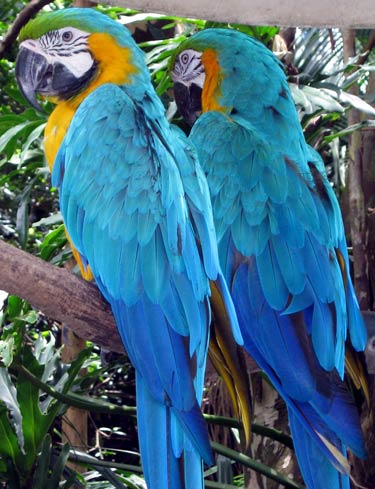 The literacy rate is over 90%, which gives Costa Rica a large, educated middle class, a huge advantage over its neighbors. You'll find shopping centers here as sophisticated as any in the U.S. Nicaraguans have been flooding into the country illegally for years, making up most of Costa Rica's unskilled labor force and creating the same social and economic dynamics as between the U.S. and Mexico. The literacy rate is over 90%, which gives Costa Rica a large, educated middle class, a huge advantage over its neighbors. You'll find shopping centers here as sophisticated as any in the U.S. Nicaraguans have been flooding into the country illegally for years, making up most of Costa Rica's unskilled labor force and creating the same social and economic dynamics as between the U.S. and Mexico.
According to the Americans we met who've lived and worked in Costa Rica for many years, the government agencies are as corrupt and inefficient as in other Central American countries, except that there are programs in place which protect the environment, encourage tourism and investment, and promote the welfare of the people. These programs may be administered corruptly and inefficiently, but that doesn't necessarily make them unbeneficial! Most travelers agree that roads in Costa Rica are probably the worst in Central America. We were told this is because so much of the money gets siphoned off and very little is left for highways.
We nearly forgot to mention this is a country with no army, which must save them a bundle, too. How, with no army, Costa Rica got to be a member of the "Coalition of the Willing" is a great mystery! (A footnote: since writing this, we learned that in the 1980's U.S. foreign aid to Costa Rica was contingent upon its support of the Contras in Nicaragua, which may help to explain this more recent collaboration). Still, many Ticos are proud of their country for spending money on education rather than weapons and are happy to tell you that over 25% of the land is protected in National Parks. A wonderful thing for all of us because this tiny country possesses the greatest density of species in the world.
 Because we'd spent so much time crossing the frontera, we decided to drive just to Liberia, about 80km from the border, and found a decommissioned trailer park outside the city with a row of electrical and water hookups in a field, long since disconnected. But they had a very nice pool. We parked on an old concrete slab next to the pool, barbequed chicken in the rain, and after a few hours a guy came over to say hi and collect the rent, $5/night. Liberia is a totally modern town, the economic hub of Guanacaste, with car dealerships, shopping centers, wireless internet, the works. At a grocery store, Rus was shocked when Kathleen found his favorite beer, Stella Artois, all the way from Belgium, sitting on the shelf like it was nothing special, plus peanut butter with nothing but salt added, and organic baby carrots for Kathleen. Photo above: Pan American Highway in Costa Rica Because we'd spent so much time crossing the frontera, we decided to drive just to Liberia, about 80km from the border, and found a decommissioned trailer park outside the city with a row of electrical and water hookups in a field, long since disconnected. But they had a very nice pool. We parked on an old concrete slab next to the pool, barbequed chicken in the rain, and after a few hours a guy came over to say hi and collect the rent, $5/night. Liberia is a totally modern town, the economic hub of Guanacaste, with car dealerships, shopping centers, wireless internet, the works. At a grocery store, Rus was shocked when Kathleen found his favorite beer, Stella Artois, all the way from Belgium, sitting on the shelf like it was nothing special, plus peanut butter with nothing but salt added, and organic baby carrots for Kathleen. Photo above: Pan American Highway in Costa Rica
Arenal, a volcano, a lake and a hot river
Next morning we continued east to Lago de Arenal, a very beautiful natural lake expanded into the country's largest by a dam and hydroelectric plant, and named after the large and lively volcano on it's eastern shore. On the way we met an expatriot who stopped us to ask if we'd sell our rig and 20 minutes later invited us to stay at his mountaintop retreat. We detoured to find it, but got hung up in a hole in his driveway and decided to move on. Our goal was the famous Tabacon Hot Springs, but it was getting late and we could see weren't going to make it. Kathleen saw a sign for a hotel called Tilawa and said "Turn here!"
 We drove up a steep but well-maintained road to arrive at a classy place with panoramic views, a pool, spa, restaurant, organic gardens, all surrounded by jungle, with a choice of trails down to the lake. The owner wasn't around just then, and the receptionist, naturally, couldn't give us permission to park until she spoke with him. We decided to have a beer in the lounge area while we waited. Before long a nice-looking couple came down to welcome us, saying they'd just talked to the receptionist and we sure must have some stories to tell, after all our travels. That was our permission. It was $20/night to camp there, high for Costa Rica, but we thought well worth it. We drove up a steep but well-maintained road to arrive at a classy place with panoramic views, a pool, spa, restaurant, organic gardens, all surrounded by jungle, with a choice of trails down to the lake. The owner wasn't around just then, and the receptionist, naturally, couldn't give us permission to park until she spoke with him. We decided to have a beer in the lounge area while we waited. Before long a nice-looking couple came down to welcome us, saying they'd just talked to the receptionist and we sure must have some stories to tell, after all our travels. That was our permission. It was $20/night to camp there, high for Costa Rica, but we thought well worth it.
Our host, Jean-Paul, came to Costa Rica from New Mexico some 17 years ago, bought bare land here and built the hotel from scratch, using his own design and construction techniques. The buildings are all of reinforced concrete and massively-constructed, painted with a thin, pigmented cement slurry which never needs recoating.The lobby (with free wifi) and restaurant areas are huge, offering many comfortable seating areas, all with gorgeous views .We've found many jewels in our travels, and the Hotel Tilawa is one of them. Jean-Paul and his wife Helga, from California, are constantly in motion, with new projects, answering the phone, instructing workers, helping guests with directions, etc., but still take time in the morning to sit out on the patio together, talk over the day ahead, and gaze out at the lake while they sip their coffee. They obviously enjoy each other immensely, and the life they've created for themselves.

After a couple of rejuvenating days at Tilawa (did we mention they have a massage therapist, a good one!), it was time to push on to Tabacon, which we'd visited on our first trip to Costa Rica three years earlier. The Rio Tabacon, as the name suggests, is more than a hot springs; it's a small, hot, fast-running river, nearly big enough to kayak. Its source is somewhere at the foot of the classically cone-shaped Volcan Arenal, very big, very active, and very close.

The majestic Volcan Arenal
When clouds weren't obscuring our view of the volcano, we spotted rivulets of smoking lava running down the sides until they solidified, and once saw a boulder as big as a car blow out of the crater and tumble halfway down the mountainside before it came to rest. The government wants to shut the resort down because of the danger (last time, the volcano shut it down without the government's help), and signs everywhere warn that you are in a dangerous active volcano zone. We took precautions, though: we parked facing out.
We got our suits and towels, went to the Tabacon gate and saw that the entrance fee was now $45. For the time we intended to stay, it seemed a bit much, so we opted instead for the less expensive Las Fuentes, a short walk downstream, which most of the Ticos use. Las Fuentes was closed, so we followed some would-be bathers who looked knowledgeable down a trail through the trees and discovered a series of warm rapids and inviting pools as the river flowed between the commercial facilities. Several families were enjoying the waters absolutely free of charge.
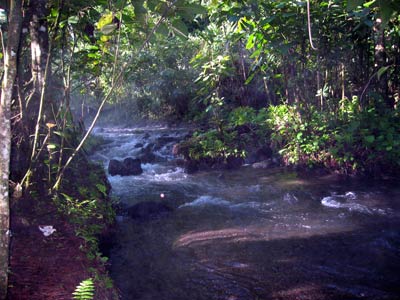 < Photo: The Rio Tabacon is so HOT it steams! < Photo: The Rio Tabacon is so HOT it steams!
We fought the current upstream, found our own pool and luxuriated in the ideal-temperature water for a couple of hours. Then we returned to the rig, got dressed up and strolled over to the very fancy restaurant at the Tabacon Resort, where the tables are set with so many wine glasses there's hardly room for the salt & pepper shakers. They create designs on your plate with the sauces, serve menu items you'd expect to find in San Francisco, and try daring flavor combinations adding tropical fruit in original ways. We enjoyed a fine dinner there, then hailed a hotel shuttle to return us to our rig through an evening downpour. Hey, we didn't come here to suffer!
Kathleen suffered that night though, itching intensely and breaking out in hives. We'll never know what caused the reaction but she suspects the minerals or something in the fine grains of mud/sand from the river, which we sat in for hours. Locals smear it on their skin and say it's very good for you. Kathleen tried it, of course, never one to miss a beauty treatment.
 
San Jose
It was nearly August, and time was rushing toward our son Jamie's wedding date of September 17. We'd made no arrangements as yet to ship our rig to South America, or any reservations to fly home for the wedding. The thing about plane reservations is, they always want to know what airport you're leaving from and when, and we had no idea!
 We decided to head into the capitol, San Jose, to follow a lead we had for a shipping agent that could arrange transport from Costa Rica directly to Ecuador. We wanted to be in South America by the time we flew home and have the shipping of our rig behind us, as it promised to be a complex and time-consuming chore. Arriving at the very comfortable Belen Trailer Park outside San Jose, owned by Laurie and Juan, an American/Costa Rican couple, we set up camp and made for an internet cafe to email the shipping agent. That evening, Laurie found his phone number from some previous customers who'd used him, and her sister Terry helped us reach him by phone the next day. Unfortunately, he was no longer dealing with larger vehicles, only those small enough to fit inside a container. He recommended going to Panama.
So we did. But our camp in Belen was so comfortable and homey, it was hard to leave. The climate here in the central valley, where about 80% of the population is concentrated, is just about perfect year-around. You can find anything you need here, and thousands of gringos flock to San Jose every year to buy resort condos, get cheap cosmetic surgery, and do other stuff that's not legal here or anywhere else.
None of those appealed to us, but we were ecstatic to replace our lost sewer hose, a gift from our Belen neighbor Dick, an American who moved his trailer into the park permanently and didn't need his portable hose anymore. If you've ever looked for rv parts outside the U.S. you will appreciate what amazing good fortune that was!
A birder's paradise: Savagre River, San Gerado de Dota

Before leaving Costa Rica, though, we wanted to see the Savegre River valley, a place our host Laurie and sister Terry had just returned from and raved about. Laurie has lived here since 1974, so when she raves, we pay attention. We climbed 11,000ft into the mountains south of San Jose on the Pan American Highway, near one of the highest points in Costa Rica, Cerro de la Muerta. Then we dropped down to 10,000ft and turned off the highway onto a very steep one-lane, mostly paved road to the valley floor.
In less than 5 miles we dropped 2,771 ft. It was the scariest road we've been on so far. On a really bad stretch, we met a truck loaded with horses, and tried to back up to let them pass. Rus shifted into reverse, pressed the accelerator, and nothing happened; too steep. Fortunately on the second try, with more juice, it caught, and we backed into a slight flare in the road on the cliff's edge. We both pulled in our mirrors and the truck edged past. But the views were great, like flying over in a plane!
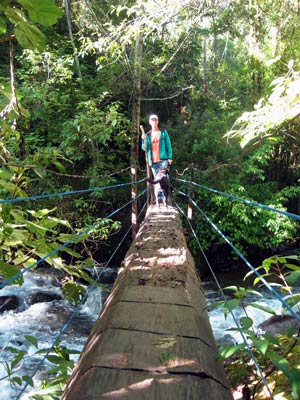 We finally descended into the lovely Rio Savegre valley, undiscovered in Post-Columbian times until the 1950's, when a few pioneers moved in, cleared some of the cloud forest to plant apple and peach orchards, planted rainbow trout in the river, and just sat around in their little patch of paradise. One of them had the idea that others might like to see the place too, built a few cabins for his fishing friends and punched an access road through the jungle. He planted gardens, built some more cabins. Then he stopped clearing the forest and convinced his neighbors to do the same. They planted trees that bear fruit favored by local birds, particularly the resplendent quetzal. The orchards are still the primary source of income for the residents of the Savegre, but eco tourism, particularly birdwatching, is quickly gaining ground. We finally descended into the lovely Rio Savegre valley, undiscovered in Post-Columbian times until the 1950's, when a few pioneers moved in, cleared some of the cloud forest to plant apple and peach orchards, planted rainbow trout in the river, and just sat around in their little patch of paradise. One of them had the idea that others might like to see the place too, built a few cabins for his fishing friends and punched an access road through the jungle. He planted gardens, built some more cabins. Then he stopped clearing the forest and convinced his neighbors to do the same. They planted trees that bear fruit favored by local birds, particularly the resplendent quetzal. The orchards are still the primary source of income for the residents of the Savegre, but eco tourism, particularly birdwatching, is quickly gaining ground.
After jockeying into position, we crept across the river to the Alberque Savegre, owned by the same guy who planted trout in the river in the '50's, collapsing just a tiny corner of the bridge. We asked if we could park somewhere for the night, were gladly given permission, and made dinner reservations with time to spare for an afternoon hike.
This isn't one of the national parks Costa Rica is famous for, just an area of combined use that the various owners have collectively agreed to protect for everyone's benefit. Where the orchards end, the cloud forest begins, and the river runs clear and cold down the center of this tiny valley. After a steep and invigorating hike, we returned to a wonderful meal in the lodge's restaurant, feasting on their excellent rainbow trout. The staff there were exceptionally friendly to us, maybe because we were the only ones there who talked to them. The other guests, mostly European eco tourists, kept pretty much to themselves.
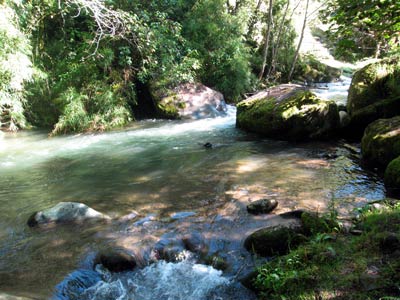 In the morning we rose early and took a hike downstream, following the Savegre to a dramatic catarata (waterfall), where a house-sized boulder had fallen across the river, creating a cave to contain the falls. Very exciting, and slippery too. Ziggy was invigorated to swim in cold water again. We met an American birder on the way back, who told us the tiny country of Costa Rica has more bird species than the United States and Canada combined! We never saw a quetzal, but as we were talking in the forest, a close cousin, big, red and beautiful, landed in a nearby tree and stared down at us. In the morning we rose early and took a hike downstream, following the Savegre to a dramatic catarata (waterfall), where a house-sized boulder had fallen across the river, creating a cave to contain the falls. Very exciting, and slippery too. Ziggy was invigorated to swim in cold water again. We met an American birder on the way back, who told us the tiny country of Costa Rica has more bird species than the United States and Canada combined! We never saw a quetzal, but as we were talking in the forest, a close cousin, big, red and beautiful, landed in a nearby tree and stared down at us.

We're not up on local slang but think this trail sign in the forest means, "Either we take care of nature or we're fucked!"
Returning to the lodge, we had a late breakfast, bid "Pura Vida!" to our friends on the staff, engaged our 4-wheel-drive, and started back up the hill. To make the grade, we were prepared to unload the moto, empty our tanks, offload extra gear, etc, but the rig did fine and felt safe. Unfortunately we met another truck our size coming down loaded with building materials, but with patience and courage we found our ways past each other.
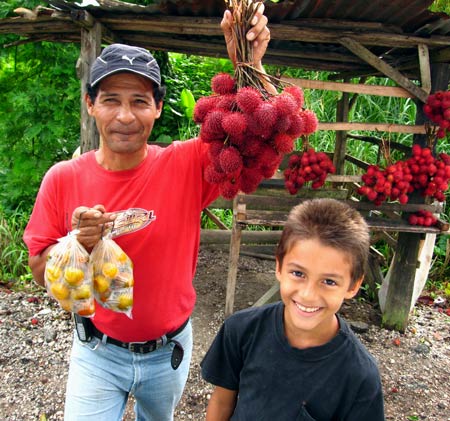
Mamon for sale, tastes delicious!
Did we mention Costa Rica is beautiful? The rest of the day, climbing to 11,000ft, then dropping to sea level, through river valleys, forests and farmland, we experienced the real-life IMAX of Costa Rica. We're so glad we made this trip through Central America during the rainy season, when everything is so lush and green, and the nearly daily rains provide a welcome relief to the tropical heat. It hardly ever rains enough to stop us from anything, only enough to cool us off, and usually just in the late afternoon or evening.
Our day's drive ended in Rio Claro, near the Panama border, where we stopped at the Hotel Impala and were given permission to park in their lot for $3.00, which we thought was very reasonable. In the morning, though, when Rus went to pay, he discovered we could have rented a room for another dollar!
Pura Vida, everyone!
|

